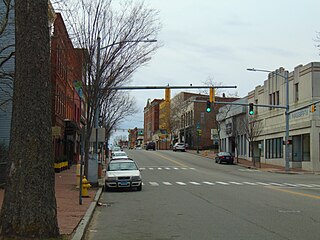
Willimantic is a census-designated place located in the town of Windham in Windham County, Connecticut, United States. It is a former city and borough. Known as "Thread City" for the American Thread Company's mills along the Willimantic River, it was a center of the textile industry in the 19th century. Originally incorporated as a city in 1893, it entered a period of decline after the Second World War, culminating in the mill's closure and the city's reabsorption into the town of Windham in the 1980s. Heroin use, present since the 1960s, became a major public health problem in the early 2000s, declining somewhat by the 2010s. Though the city was a major rail hub, an Interstate Highway has never passed within ten miles, despite early plans to connect it.

Dealey Plaza is a city park in the West End Historic District of downtown Dallas, Texas. It is sometimes called the "birthplace of Dallas". It also was the location of the assassination of United States President John F. Kennedy, on November 22, 1963; 30 minutes after the shooting, Kennedy died at Parkland Memorial Hospital. The Dealey Plaza Historic District was named a National Historic Landmark on November 22, 1993, the 30th anniversary of the JFK assassination, to preserve Dealey Plaza, street rights-of-way, and buildings and structures by the plaza visible from the assassination site, that have been identified as witness locations or as possible locations for assassin(s).

The Willimantic Footbridge is a pedestrian bridge in the Willimantic section of Windham, Connecticut. Built in 1906, it extends from Main Street southward, across Riverside Drive, railroad tracks, and the Willimantic River, connecting downtown Willimantic to the residential area south of the river. It is one of a small number of pedestrian bridges built in the early 20th century to survive in the state. It was listed on the National Register of Historic Places in 1979.
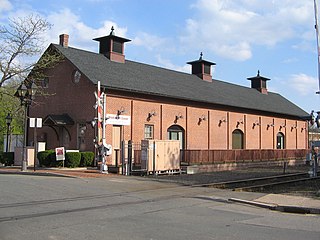
The Hartford & New Haven Railroad Freight Depot is a historic building at 40 Mechanic Street in downtown Windsor, Connecticut, across the street from the equally historic Hartford & New Haven Railroad Depot. Built about 1870, it is a well-preserved example of a Gothic Revival freight depot. It was listed on the National Register of Historic Places in 1988. It is now the home of the Windsor Arts Center, a non-profit place that exhibits the work of visual and performing artists.

The Main Street Historic District encompasses the historic portion of the central business district of Willimantic, in Windham, Connecticut. The district encompasses the commercial business district of Willimantic and is roughly linear along Main Street and Riverside Drive between Church Street and Bridge Street. It was first listed on the National Register of Historic Places in 1982. Its area was increased in 1992 to include the Hall and Bill building on North Street, built in 1889 by one of Willimantic's leading printers.

The Prospect Hill Historic District encompasses a large residential area in the Willimantic section of Windham, Connecticut. Located north of the Main Street commercial district, it was developed between about 1865 and 1930, and is one of the state's largest historic districts, with more than 800 contributing buildings. It is roughly bounded by Valley, Jackson, Bolivia, Washburn, Windham, and High Streets, and contains one of the state's largest single concentrations of Victorian-era residential architecture. It was listed on the National Register of Historic Places in 2003.

The Downtown Springfield Railroad District is a historic district encompassing a group of early 20th century railroad-related buildings in Springfield, Massachusetts. They are in an area roughly bounded by Lyman, Main, Dwight, and Frank B. Murray Streets. The district includes Springfield's Union Station, the old freight house, commercial warehouses, and a retaining wall and bridge designed in part by H. H. Richardson. The district was added to the National Register of Historic Places in 1983.

The William Jillson Stone House is a historic house museum at 561 Main Street inside Jillson Square Park, in the Willimantic section of Windham, Connecticut. Built in 1825-27, it is a rare local instance of a stone house, built by one of the area's early industrialists. It is now maintained by the Windham Historical Society, and was listed on the National Register of Historic Places in 1971.

The Willimantic Elks Club is a historic Elks lodge at 198 Pleasant Street in the Willimantic section of Windham, Connecticut. Built in 1925 for a lodge founded in 1914, it is one of the finest examples of Tudor Revival architecture in the region, and has been a major site of social events in the community since. The building was added to the National Register of Historic Places in 2005.

Willimantic Armory is a historic armory building on Pleasant Street in Windham, Connecticut. It served the Connecticut National Guard from 1913 until 1980 when the building was sold to developers who converted the building into apartments.

Union Station, also known as Union Station and Burlington Freight House, is located near the riverfront in downtown Davenport, Iowa, United States. It is listed on the National Register of Historic Places. The buildings are in a section of downtown with several historic structures. Across Ripley Street to the west is the Chicago, Milwaukee, St. Paul and Pacific Freight House, and to the east across Harrison Street is the Dillon Memorial. On River Drive northwest from the Burlington Freight House is The Linograph Company Building. Across Beiderbecke Drive to the south are the W.D. Petersen Memorial Music Pavilion and the Mississippi River.

The Broadway–Livingston Avenue Historic District is located at the junction of those two streets in Albany, New York, United States. It includes seven buildings remaining from an original 20, all contributing properties, and a Warren truss railroad bridge. In 1988 the area was recognized as a historic district and listed on the National Register of Historic Places.
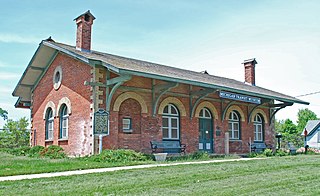
Mount Clemens station is a historic railroad depot located at 198 Grand Street in Mt. Clemens, Michigan. Young Thomas Edison learned telegraphy at this station. The building was listed on the National Register of Historic Places in 1981 as the Grand Trunk Western Railroad, Mount Clemens Station and designated a Michigan State Historic Site in 1973. It is now operated as the Michigan Transit Museum.
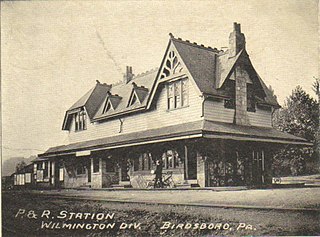
Birdsboro station can refer to three passenger railway stations in or near Birdsboro, Pennsylvania.

The Bellows Falls Times Building is a historic newspaper plant on Bridge and Island Streets in Bellows Falls, Vermont. The complex of three buildings was developed in the 1930s by the Vermont Newspaper Corporation, and served as home for the Bellows Falls Times newspaper until 1965, when it was consolidated with other local newspapers. The main building is a particularly fine local example of Colonial Revival design. The complex was listed on the National Register of Historic Places in 1990.

The Gas Station at Bridge and Island Streets is a historic automotive service station in Bellows Falls, Vermont. Built about 1935, it is a modest yet well-preserved example of period roadside commercial architecture of the period. The Colonial Revival building continues to be used as a service facility; it was listed on the National Register of Historic Places in 1990.
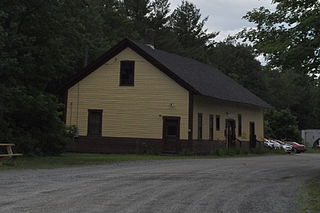
The Fairlee Railroad Depot is a historic railroad station at 320 United States Route 5 in the village center of Fairlee, Vermont. Built in 1848 and used in active service until 1972, it is one of the few surviving first-generation railroad station buildings in the state. Now used as a retail space, it was listed on the National Register of Historic Places in 1998.
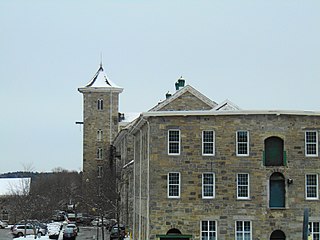
The Jillson Mills is a mill complex in Willimantic, Connecticut. The mills produced cotton thread throughout the lifespan of the operation of the mill.

The Windham Town Hall is a town hall in Willimantic, Windham, Connecticut.

The Chicago and West Michigan Railroad Charlevoix Station is a railroad depot located on Chicago Avenue in Charlevoix, Michigan. It was listed in the National Register of Historic Places in 1995.






















